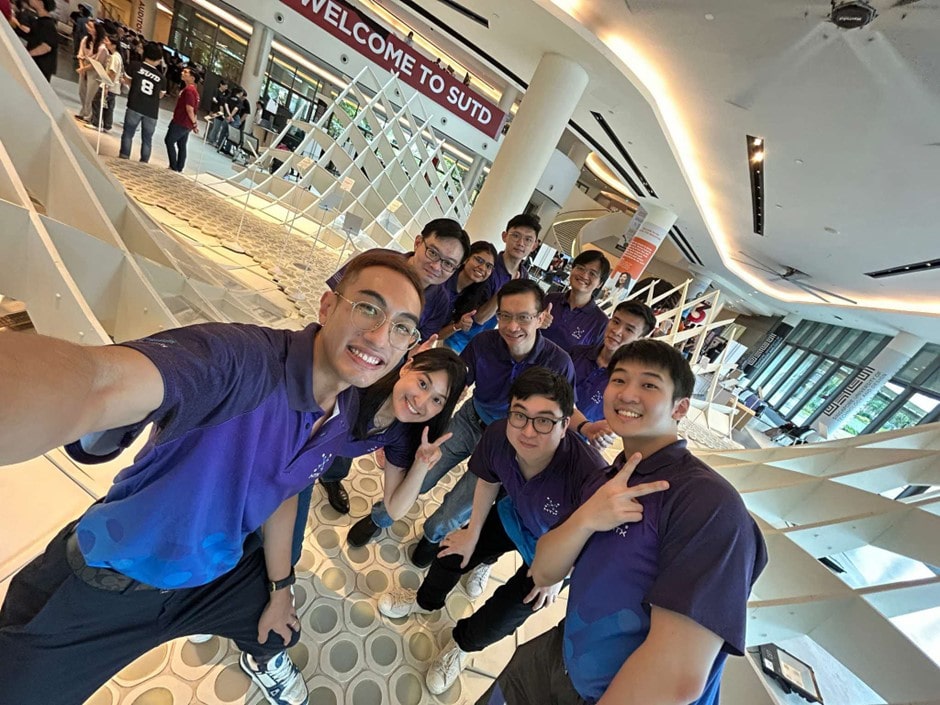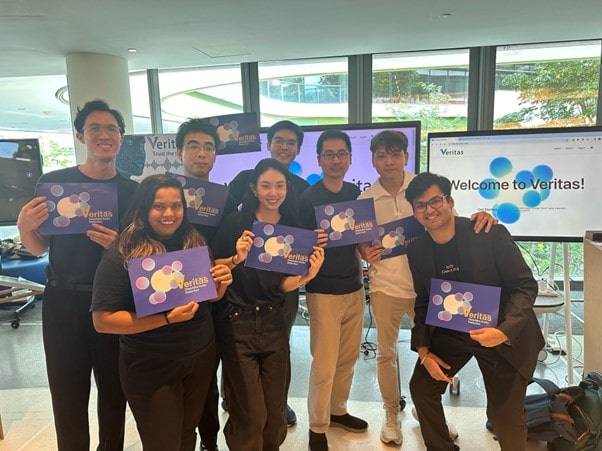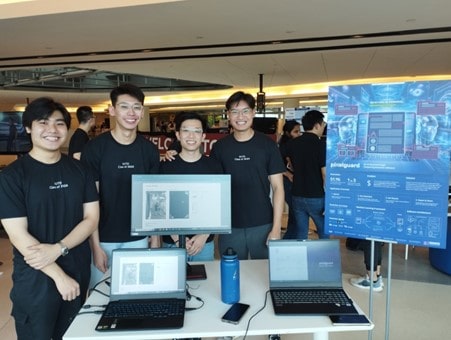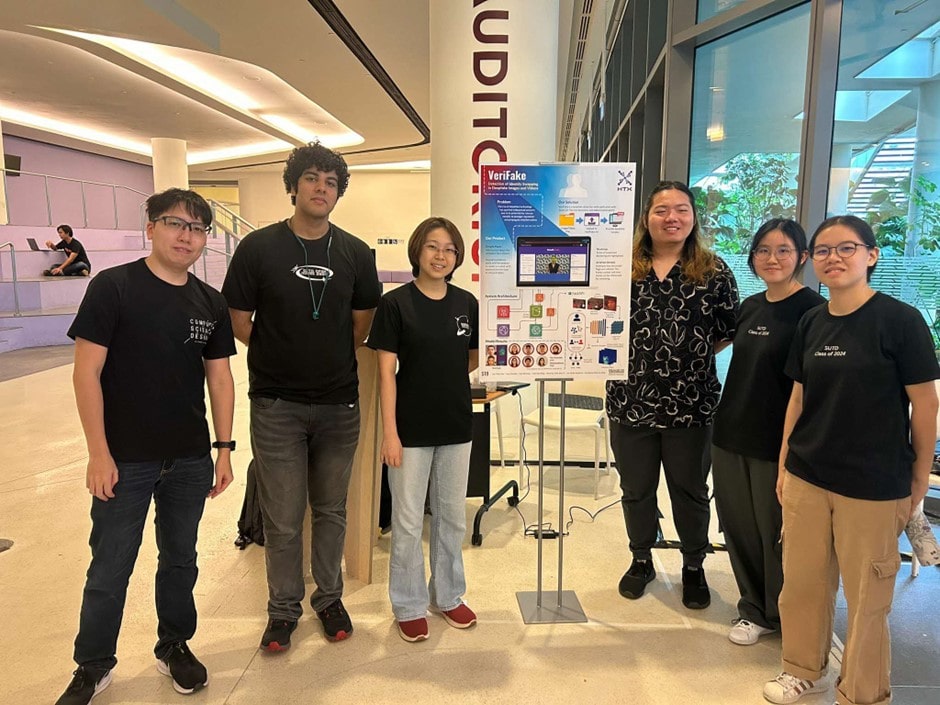 The HTX mentors at this year’s SUTD Capstone Design Showcase. (Photo: HTX)
The HTX mentors at this year’s SUTD Capstone Design Showcase. (Photo: HTX)
Deepfakes have emerged as a major social downside of generative artificial intelligence (Gen AI). Where criminals previously had to master tools like Photoshop to create fake images, Gen AI has made the creation of fake audio, image, and video files extremely fast and easy, and deepfake audio, images, and videos have proliferated on social media and elsewhere. The following video from the Singapore University of Technology and Design’s (SUTD) VeriFake Capstone project – which we will describe below – shows how realistic deepfakes have become. Imagine how much more dangerous scammers will be with tools like deepfakes to trick their victims!
HTX has been vigilant to the deepfake scourge, and its Sense-making & Surveillance (S&S) Centre of Expertise (CoE) has developed AlchemiX, an audio and video deepfake detector. With its expertise in deepfake detection, this year S&S CoE mentored three deepfake-related Capstone projects at Singapore University of Technology and Design (SUTD).
The first, Veritas, is an audio deepfake detector. Veritas’ AI models have been trained to identify whether audio clips – including those with Singaporean accents – are deepfakes. This video shows how Veritas identifies audio deepfakes:
 The Veritas team. Front row, from left to right: Acqquilaa Bathumalai, Ma Yucong, and Umang Sanjeev Gupta; back row, from left to right: Noah Kong Dean, Lee Cheng Xin, Lee Chang Zheng, Zhang Zhichao (HTX mentor), and Tan Jian Hong (HTX mentor). Jyotit Kaushal was not in the photo. (Photo: HTX)
The Veritas team. Front row, from left to right: Acqquilaa Bathumalai, Ma Yucong, and Umang Sanjeev Gupta; back row, from left to right: Noah Kong Dean, Lee Cheng Xin, Lee Chang Zheng, Zhang Zhichao (HTX mentor), and Tan Jian Hong (HTX mentor). Jyotit Kaushal was not in the photo. (Photo: HTX)
HTX mentor Zhang Zhichao was impressed with Veritas and shared, “It was a great experience to mentor these students in their exploration into the topic of audio deepfakes. It gave us a wider range of viewpoints and options for us to consider incorporating into our own work.”
Where Veritas detects audio deepfakes, PixelGuard, the second Capstone project, detects image tampering. PixelGuard’s AI models have been trained to detect the manipulation and tampering of images for malicious purposes such as signature and document forgery. The following video shows how the authorities can use PixelGuard to identify whether an image has been tampered with:
 The PixelGuard team. From left to right: Ryan Kaw Zheng Da, Jarron Ng Jing Heng, Raymond Harrison, and Nigel Mun Yit Hung. Jon-Taylor Lim Ming Te, Ethan Pang Yew Ju, and Foo Chuan Shao were not in the photo. (Photo: HTX)
The PixelGuard team. From left to right: Ryan Kaw Zheng Da, Jarron Ng Jing Heng, Raymond Harrison, and Nigel Mun Yit Hung. Jon-Taylor Lim Ming Te, Ethan Pang Yew Ju, and Foo Chuan Shao were not in the photo. (Photo: HTX)
These innovations won’t be confined to the classroom. HTX mentor Dr. Koa Ming Di shared that S&S CoE plans to merge two of PixelGuard’s AI models into AlchemiX, and added that both the SUTD students and their HTX mentors have benefitted from the collaboration:
“For mentors, it allows us to understand the design thinking and engineering knowledge being taught at SUTD. Students get to understand the day-to-day threats and problems faced by the Home Team, and gain insights about products being developed or used by the Home Team to solve real problems.”
The students were grateful for the support of their mentors. Ryan Kaw expressed on behalf of his team, “With the help of Dr. Koa and HTX guiding us in the right direction, we were able to push ourselves past what we learnt in the classroom and realise a project beyond our expectations.”
VeriFake, the third Capstone project, investigated the effectiveness of recent deepfake detection techniques and integrated existing deepfake detection algorithms into a standalone software platform. See how VeriFake can help users detect image and video deepfakes:
 The VeriFake team. From left to right: Lim Thian Yew, Divy Chandra, Constance Chua, Koh Aik Hong, Beverly Chee, and Yeoh Siew Ning. Benjamin Luo was not in the photo. (Photo: HTX)
The VeriFake team. From left to right: Lim Thian Yew, Divy Chandra, Constance Chua, Koh Aik Hong, Beverly Chee, and Yeoh Siew Ning. Benjamin Luo was not in the photo. (Photo: HTX)
As with the other projects, HTX mentor Ong Si Ci shared that S&S CoE may also integrate some of the features and detectors from VeriFake into AlchemiX, “Currently AlchemiX only offers audio and video deepfake detection. What the students have done includes image based deepfake detection and explainability (via heat maps), and we can implement these into AlchemiX if they are assessed to have good performance.”
Si Ci was very impressed with her mentees, “It was amazing to see how the team pooled together their skills and expertise from different faculties in SUTD to come together and build the product. It was definitely a fulfilling experience mentoring this driven and motivated team and I am proud of the achievements that they have accomplished through this project.”
The students likewise found their collaboration with HTX to be critical for their success. Divy Chandra shared on behalf of his team, “The partnership with HTX has played a pivotal role in the success of our team's Capstone project. From HTX, Ms. Ong Si Ci has been an invaluable mentor throughout our Capstone journey. Her expertise in the field and industry experience added depth to our research and approach, whilst her guidance was critical for our progress and development of our product. Additionally, HTX's Digital & Information Forensics CoE helped us understand the problem and use case better, which allowed us to fully utilise all the factors at play in the problem to ensure that our product delivers an effective solution.”

